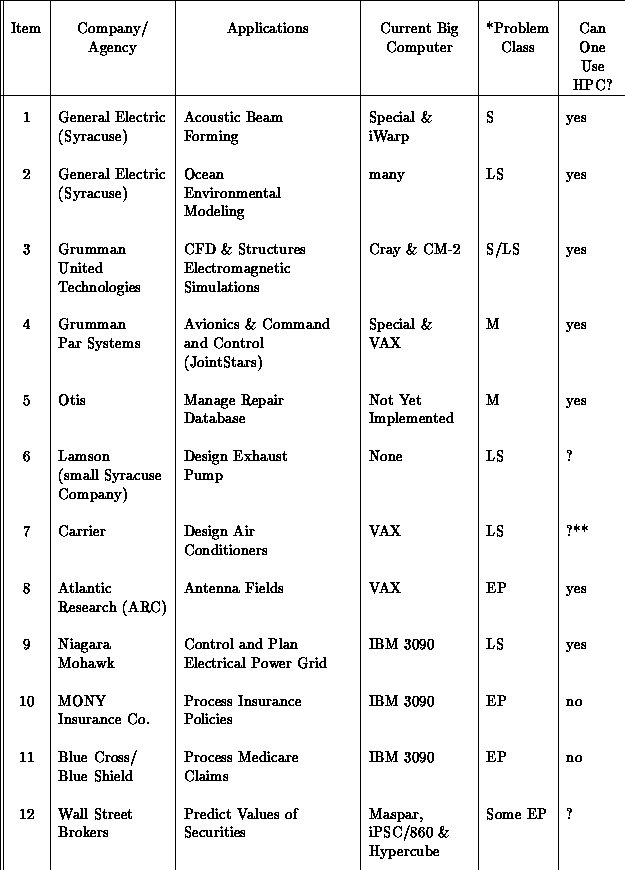




Next: 19.2 Examples of Industrial
Up: 19 Parallel Computing in
Previous: 19 Parallel Computing in
Now at Syracuse University, Fox has set up a new program ACTION
(Advanced Computing Technology is an Innovative Opportunity Now). This
is funded by New York State to accelerate the introduction of parallel
computing into the State's industry. The methodology is based directly
on that proven successful in C P. The applications scientists are now
in different industries-not in different Caltech or JPL departments.
There are many differences in detail between the projects. The basic
hardware is now available commercially and need not be developed
concurrently with applications and systems software. However, the
applications are much harder. In C
P. The applications scientists are now
in different industries-not in different Caltech or JPL departments.
There are many differences in detail between the projects. The basic
hardware is now available commercially and need not be developed
concurrently with applications and systems software. However, the
applications are much harder. In C P, a typical code was at most a
few thousand lines long and often developed from scratch by each new
graduate student. In ACTION, the codes are typically larger (say
100,000 lines) and longer lived.
P, a typical code was at most a
few thousand lines long and often developed from scratch by each new
graduate student. In ACTION, the codes are typically larger (say
100,000 lines) and longer lived.
We also find differences when we analyze the problem class. There are
fewer regular synchronous problems in industry than in academia and many
more of the metaproblem class
with several different interrelated functions.
Table 19.1 presents some initial results of a survey of
industrial applications [Fox:92e].
Note that we are at the stage analogous to the beginnings of C P
when we first wandered around Caltech talking to computational
scientists.
P
when we first wandered around Caltech talking to computational
scientists.

Table 19.1: An Initial Survey of Industry and Government Opportunities for
High-Performance (Parallel) Computing
In general, we find that the central parallel algorithms needed in
industry have usually already been studied by the research community.
Thus, again we find that, ``in principle,'' parallel computing works.
However, we have an even harder software problem and it is not clear
that the software issues key to the research applications are the same
for industry. As described in Chapter 14 for High Performance
Fortran, software standards are critical so companies can be
assured that their parallel software investment will be protected as
hardware evolves.
One interesting initial conclusion about the industrial opportunities for
parallel computers concerns the type of applications. Simulations of
various sorts dominated the previous chapters of this book and most
academic computing. However, we find that the industrial applications
show that simulation, while very promising, is not the largest market in
the long run. Rather, we live in the ``information area'' and it is in
the processing of information that parallel computing will have its
largest opportunity. This is not (just) transaction processing for the
galaxywide network of automatic teller machines; rather, it is the
storage and access of information followed by major processing
(``number-crunching''). Examples include the interpretation of data
from NASA's ``mission to planet Earth'' where the processing is
large-scale image analysis; the scanning and correlation of technical
and electronic information from the world's media to give early warning
for economic and social crises; the integration of medicaid
databases to lower the burden on doctors and patients
and identify inefficiencies. Interestingly, such information
processing is currently not stressed in the national high-performance
computing initiative.





Next: 19.2 Examples of Industrial
Up: 19 Parallel Computing in
Previous: 19 Parallel Computing in
Guy Robinson
Wed Mar 1 10:19:35 EST 1995
 P. The applications scientists are now
in different industries-not in different Caltech or JPL departments.
There are many differences in detail between the projects. The basic
hardware is now available commercially and need not be developed
concurrently with applications and systems software. However, the
applications are much harder. In C
P. The applications scientists are now
in different industries-not in different Caltech or JPL departments.
There are many differences in detail between the projects. The basic
hardware is now available commercially and need not be developed
concurrently with applications and systems software. However, the
applications are much harder. In C P, a typical code was at most a
few thousand lines long and often developed from scratch by each new
graduate student. In ACTION, the codes are typically larger (say
100,000 lines) and longer lived.
P, a typical code was at most a
few thousand lines long and often developed from scratch by each new
graduate student. In ACTION, the codes are typically larger (say
100,000 lines) and longer lived.





 P
when we first wandered around Caltech talking to computational
scientists.
P
when we first wandered around Caltech talking to computational
scientists.
